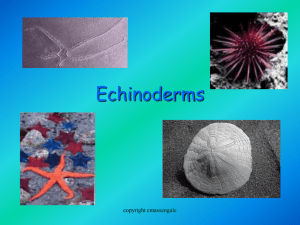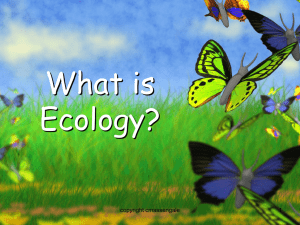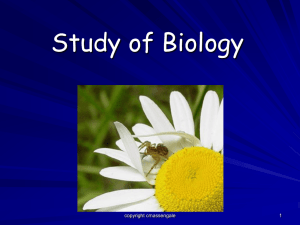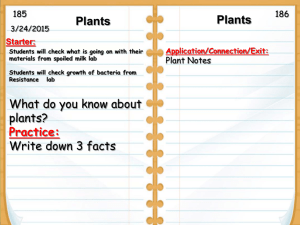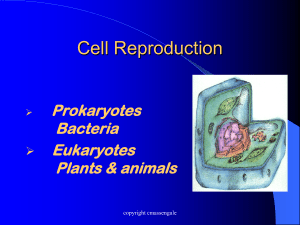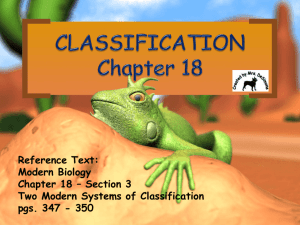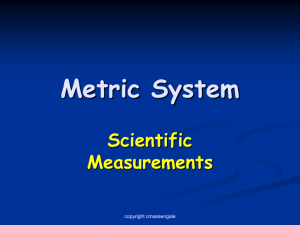What is Classification?
advertisement
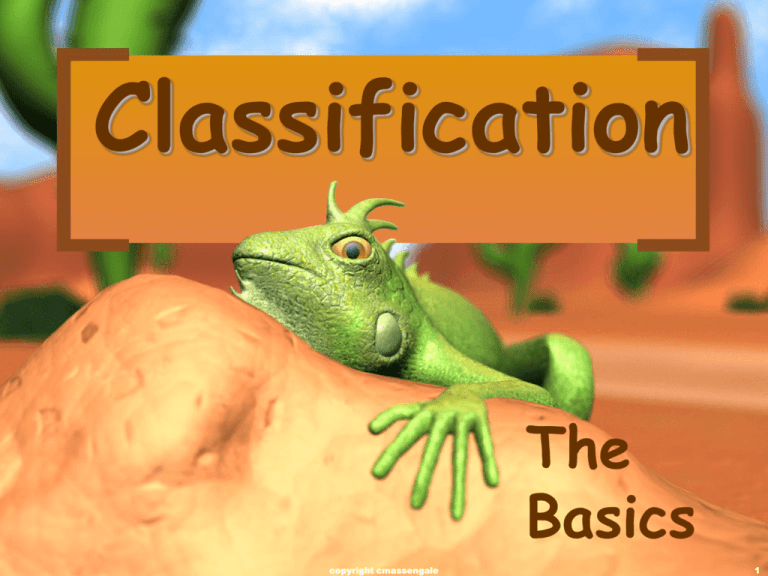
Classification The Basics copyright cmassengale 1 Species of Organisms •There are 13 billion known species of organisms •This is only 5% of all organisms that ever lived!!!!! •New organisms are still being found and identified copyright cmassengale 2 What is Classification? Classification is the arrangement of organisms into orderly groups based on their similarities Classification is also known as taxonomy Taxonomists are scientists that identify & name organisms copyright cmassengale 3 Benefits of Classifying •organisms Accurately & uniformly names •Prevents misnomers: (mis – wrong; nome – name) such as starfish & jellyfish that aren't really fish Uses same language (Latin or some Greek) for all names • Sea”horse”?? copyright cmassengale 4 Confusion in Using Different Languages for Names copyright cmassengale 5 Latin Names are Understood by all Taxonomists copyright cmassengale 6 Early Taxonomists •2000 years ago, Aristotle was the first taxonomist Aristotle divided organisms into plants & animals He subdivided them by their habitat ---land, sea, or air dwellers • • copyright cmassengale 7 Early Taxonomists •John Ray, a botanist, was the first to use Latin for naming His names were very long descriptions telling everything about the plant • copyright cmassengale 8 Carolus Linnaeus 1707 – 1778 • 18th century taxonomist • Called the • “Father of Taxonomy” Classified organisms by their structure copyright cmassengale 9 Carolus Linnaeus •Developed naming system still used today •It is called: binomial nomenclature It is a two-word name using the Genus and species copyright cmassengale 10 Standardized Naming •Binomial nomenclature used •Genus species •Latin or Greek •Italicized in print •Capitalize Genus, American Robin Turdus migratorius but NOT species copyright cmassengale 11 Binomial Nomenclature Which TWO are more closely related? copyright cmassengale 12 Classification Groups • Taxon ( taxa-plural) is a • category into which related organisms are placed There is a hierarchy (ranking) of groups (taxa) from least specific to most specific copyright cmassengale 13 Hierarchy-Taxonomic Groups Least Specific Domain Kingdom Phylum Class Order Family Genus Species copyright cmassengale Most Specific 14 Dumb King Phillip Came Over For Great Soup! copyright cmassengale 15 copyright cmassengale 16 Modern Taxonomy •Classification is based on evidence of evolutionary relationships copyright cmassengale 17 Types of Evidence 1.Homologous structures (same structure, different function) 2.Similar embryo development 3.Similarity in hereditary material (DNA, RNA, or amino acid sequence of Proteins) copyright cmassengale 18 Homologous Structures (BONES in the FORELIMBS) shows similarities in mammals. copyright cmassengale 19 Similarities in Vertebrate Embryos copyright cmassengale 20 copyright cmassengale 21 Cladogram Diagram showing how organisms are related based on shared, derived characteristics such as feathers, hair, or scales copyright cmassengale 22 Primate Cladogram copyright cmassengale 23 copyright cmassengale 24 The Taxa Domains and Kingdoms copyright cmassengale 25 Domains •Broadest, most inclusive taxon •Three domains: 1. Archea and 2. Bacteria are unicellular prokaryotes (no nucleus/organelles) 3. Eukarya – all members are eukaryotic (have nucleus/organelles) copyright cmassengale 26 Domain Archea Kingdom Archeabacteria: Probably the 1st cells to evolve (about 3.5 billion years ago!) Live in harsh environments Have cell walls (made of protein) Members can be autotrophs or heterotrophs • • • • copyright cmassengale 27 Domain Archea, cont. •Members found in: 1. Sewage treatment plants 2. Hot, acidic environments such as volcanic vents or hot springs 3. Very salty water (Dead Sea or Great Salt Lake) 4. Long-frozen ice – Antarctica and glaciers copyright cmassengale 28 ARCHAEAN copyright cmassengale 29 Domain Bacteria Kingdom Eubacteria: Some may cause disease Found in all habitats except harsh ones Also have cell walls (made of protein) Members can be autotrophs or heterotrophs • • • • copyright cmassengale 30 Domain Bacteria, cont. Members are: Important decomposers for the environment Commercially important in making cottage cheese, yogurt, buttermilk, etc. • • copyright cmassengale 31 Live in the intestines of animals copyright cmassengale 32 Domain Eukarya Divided into 4 Kingdoms: 1.Protista 2.Fungi 3.Plantae 4.Animalia copyright cmassengale 33 Protista •Most are unicellular •Some are multicellular •Some are autotrophs, some are heterotrophs •Some have cell walls (made of cellulose) •Some have chloroplasts copyright cmassengale 34 Kingdom Protista is often referred to as: The Junk Drawer Kingdom This is because it is where scientists put organisms that do not fit in any other kingdom! copyright cmassengale 35 Protists copyright cmassengale 36 Fungi • All members are multicellular, except for yeasts • Absorptive heterotrophs (break • down food outside body, then absorb it) Have cell walls made of chitin (a carbohydrate) copyright cmassengale 37 Fungi copyright cmassengale 38 Plantae • All members are multicellular • Autotrophic (Absorb sunlight to make glucose – photosynthesis) • Have cell walls made of cellulose (a carbohydrate) • Have chloroplasts (for photosynthesis) and a central vacuole (for water storage/cell support) copyright cmassengale 39 Plantae copyright cmassengale 40 Animalia •All members are multicellular •Ingestive heterotrophs (consume food and digest it inside their bodies) Feed on producers and/or consumers No cell walls or chloroplasts Have small vacuoles for fluid storage • • • copyright cmassengale 41 copyright cmassengale 42 copyright cmassengale 43 Cladogram Questions 1.In cladogram A, the earliest life forms are? 2.The 1 Eukaryotes in Cladogram A are? 3.In cladogram A, the earliest animals were? 4.From Cladogram A, List all organisms classified as Arthropods. 5.Cladogram B, List all derived characters. 6.From Cladogram B, you can assume that birds are closely related to __________ 7.The only organism to not have an Amniotic egg was the ___________ 8.In cladogram B, list all derived traits of a snake. 9.What is the definition of a cladogram? st copyright cmassengale 44
